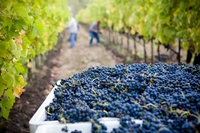Archives
October 2020
August 2020
June 2020
April 2020
January 2020
August 2019
July 2019
May 2019
August 2018
July 2018
May 2018
March 2018
November 2017
August 2017
February 2017
September 2016
January 2015
September 2014
July 2014
June 2014
May 2014
October 2013
July 2013
June 2013
May 2013
April 2013
March 2013
February 2013
January 2013
December 2012
November 2012
September 2012
August 2012
May 2012
April 2012
21 October 2020
Wine for Beginners

There’s no two-ways about it, the wine world is an intimidating one. There are dozens of different styles, types and regions to navigate - such as Italian Wine and South African Wine for example, and then there are the self-confessed wine snobs to contend with. This is the side of the wine community that nobody really likes, but they put up with it because wine is delicious.
With a basic understanding of the different types of wines and their tastes, you will be able to take a regular, slightly boring mid-week meal and pair it with something to make it truly exceptional. So, as it turns out, there is a very good reason to learn about the different wines and how they taste.
Understanding Wine Makes it Taste Better
Studies have clearly shown that having more complex descriptions of red and white wine, actually make those particular wines taste better. If you think about it, this does make sense. If you have more vocabulary to describe what you’re tasting, your brain will be better equipped to discern the subtle flavours that are present.
What’s the Difference Between Red and White Wine?
So we know that you won’t need help recognising a white wine versus a red wine - they look and taste very different. But, it’s worth your while to understand why they look and taste so different. The culprit behind this, in both cases - the skins, and a little something they bring to the party called tannins.
So, What are Tannins?
Tannins are a naturally occurring substance in grapes and other fruits and plants (like tea, for example). The taste of tannin is often described as bitter, causing a dry and puckery feeling in the mouth. Tannins end up in your wine when the vintner allows the skins to sit in the grape juice as it ferments. This is also how wines get their color. Wines that have little or no skin contact end up pink or white, with far fewer tannins. Wines that ferment with the skins for a longer period end up red, with high tannin content. As you’d imagine, red grape skins have more tannins than white grape skins.
Tannin provides the backbone of red wine, which is why you might describe a red wine as “firm” or “leathery” or just plain “bitter.” Tannin also gives red wine texture, making it feel “smooth” and “soft” or “rough” and “chewy.” In general, the darker the wine, the higher the tannin and the “bolder” the taste.
White wine has tannin, but not enough to make it the star of the show. Instead, white wines are backboned by acidity. That’s why you might say a wine is “crisp” or “tart.” Or, if there isn’t enough acidity, you might call a white wine “flat.”
Rosé, or blush wine, is pink in color. It gets that way because it is allowed to stay in contact with the red grape skins for a relatively short time compared to red wine. On the spectrum between red and white, rosé is much closer to the light side, with relatively low tannin.
What Are The Four Key Wine Descriptors?
Sweetness - Needs no explanation. The opposite of sweet is dry. A wine can also be medium-dry or off-dry (i.e., just a hint of sweetness, but almost too faint to move the needle).
Acidity - We already talked about this. Acidity is a big deal for white wines, and it makes them refreshing and crisp (or “sour” if it's overdone). Lower acidity makes a wine taste “fat.”
Tannin - Another one we’ve already covered. It’s all about the tannins for red wine. High tannin wines are astringent, maybe even bitter and inky. Lower tannin wines are smooth and soft, and depending on your tastes, more drinkable.
Body - This refers to the perceived “weight” and viscosity of the wine. A full-bodied wine feels thick, coating the sides of the glass as you swirl. A light-bodied wine is almost like water. A medium-bodied wine is in-between.
There's a fifth thing to be aware of when describing wine—flavor. Unlike the four key descriptors, flavor encompasses every descriptor under the sun and is far more subjective.
Flavors - If you’re not sure, don’t bother diving into descriptors like graphite, barnyard, and other flavors you’ve (hopefully) never tasted. Instead, stick to the most relatable flavors like fruity, earthy, spicy, smoky, or flowery.